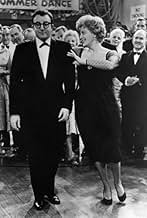Un professeur d'université d'âge mûr s'emballe pour une fillette de quatorze ans.Un professeur d'université d'âge mûr s'emballe pour une fillette de quatorze ans.Un professeur d'université d'âge mûr s'emballe pour une fillette de quatorze ans.
- Nommé pour 1 oscar
- 2 victoires et 9 nominations au total
Terry Kilburn
- Man
- (as Terence Kilburn)
Histoire
Le saviez-vous
- AnecdotesPeter Sellers modeled the voice of his character Clare Quilty on that of his director, Stanley Kubrick.
- GaffesDirector Stanley Kubrick walks out of the very first interior shot (center to right bottom) of Humbert entering Quilty's house.
- Citations
Charlotte Haze: Do you believe in God?
Humbert Humbert: The question is does God believe in me?
- Générique farfeluThe credits are played over footage of Lolita's toenails being painted.
- Autres versionsThe scene where Lolita first "seduces" Humbert as he lies in the cot is a good 10 seconds longer in the British cut of the film. In the U.S. cut, the shot fades as she whispers the details of the "game" she played with Charlie at camp. In the U.K. print, the shot continues as Humbert mumbles that he's not familiar with the game. She then bends down again to whisper more details. Kubrick then cuts to a closer shot of Lolita's head as she says "Well, allrighty then" and then fades as she begins to descend to Humbert on the cot. The British cut of the film was used for the Region 1 DVD release.
- ConnexionsEdited into Hai-Kubrick (1999)
Commentaire en vedette
A significant part of Stanley Kubrick's genius was his ability to translate a literary style into a visual one. It is demonstrated nowhere more brilliantly than in LOLITA and A CLOCKWORK ORANGE.
LOLITA is perhaps the more stunning accomplishment, in that Nabokov's style is complex and multi-layered. Yet Kubrick captures the effect of it in camera angles and movements, in timing and point of view.
The broadest layer of Nabokov's novel, the parable of the aging culture of Europe trying to revivify itself by debauching the seductive young culture of America, is really missing in the film. But everything else is there, despite the fact that the film departs from the exact events of the novel.
Not to say that the film depends on the novel. It stands by itself quite easily. But it succeeds brilliantly in conveying the ideas and feelings that are the core of the novel, and it does so in completely cinematic terms. If films are to be based on works of literature, this is the way to do it, and the way it is almost never done.
LOLITA is perhaps the more stunning accomplishment, in that Nabokov's style is complex and multi-layered. Yet Kubrick captures the effect of it in camera angles and movements, in timing and point of view.
The broadest layer of Nabokov's novel, the parable of the aging culture of Europe trying to revivify itself by debauching the seductive young culture of America, is really missing in the film. But everything else is there, despite the fact that the film departs from the exact events of the novel.
Not to say that the film depends on the novel. It stands by itself quite easily. But it succeeds brilliantly in conveying the ideas and feelings that are the core of the novel, and it does so in completely cinematic terms. If films are to be based on works of literature, this is the way to do it, and the way it is almost never done.
- metaphor-2
- 7 mars 1999
- Lien permanent
Meilleurs choix
Connectez-vous pour évaluer et surveiller les recommandations personnalisées
Détails
Box-office
- Budget
- 2 000 000 $ US (estimation)
- Brut – à l'échelle mondiale
- 7 411 $ US
- Durée2 heures 33 minutes
- Couleur
- Rapport de forme
- 1.66 : 1
Contribuer à cette page
Suggérer une modification ou ajouter du contenu manquant




































